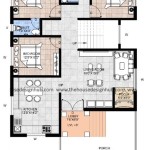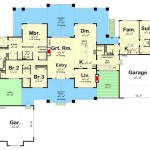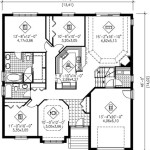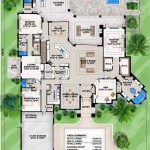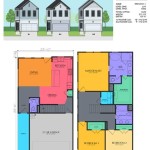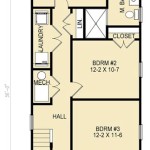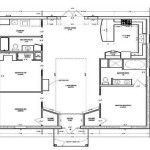L-Shaped Ranch House Floor Plans: Exploring Functionality and Design
The L-shaped ranch house floor plan represents a popular architectural style known for its single-story design and distinctive shape. This configuration offers a unique blend of practicality, aesthetic appeal, and spatial efficiency, making it a favorable choice for homeowners seeking a comfortable and adaptable living environment. This article examines the key characteristics, benefits, design considerations, and potential variations of L-shaped ranch house floor plans, providing a comprehensive understanding of this residential architecture.
Defining Characteristics of L-Shaped Ranch Homes
The defining characteristic of an L-shaped ranch home is its layout, resembling the letter "L" when viewed from above. This configuration typically separates the house into two distinct wings, often dedicated to different functions. One wing commonly houses the living areas, such as the living room, dining room, and kitchen, while the other wing typically contains the bedrooms and bathrooms. The "L" shape often creates a natural outdoor space, such as a patio or garden, within the angle of the structure. This integration of indoor and outdoor living is a prominent feature appreciated by many homeowners.
Ranch-style homes, in general, are characterized by their low-pitched roofs, horizontal emphasis, large windows, and open floor plans. With the L-shaped variation, these features are often enhanced, providing increased natural light and ventilation. The single-story design also contributes to accessibility, making it a suitable option for individuals of all ages and mobility levels.
The placement of the garage is another key aspect to consider. In an L-shaped ranch, the garage is commonly integrated into one of the wings, often extending beyond or being attached to the bedroom wing. This placement can provide direct access to the house, increasing convenience, particularly during inclement weather.
Advantages of Choosing an L-Shaped Ranch House Plan
The L-shaped ranch house floor plan presents several advantages that contribute to its enduring popularity. These benefits range from spatial organization to enhanced privacy and energy efficiency.
One of the primary advantages is the effective separation of living and sleeping areas. This segregation allows for greater privacy and noise reduction in the bedroom wing, creating a more tranquil environment for rest and relaxation. Simultaneously, the living areas can be more open and conducive to socializing and entertaining.
The "L" shape itself creates a natural courtyard or outdoor living space. This space can be utilized for various purposes, such as outdoor dining, gardening, or simply relaxing. The configuration also offers increased privacy for the outdoor space, shielding it from street view or neighboring properties. This enhanced privacy adds value to the outdoor living experience.
L-shaped ranch homes can also be more energy-efficient than other house styles. The layout can be optimized to take advantage of natural light and ventilation, reducing the need for artificial lighting and air conditioning. The shorter distances between rooms can also contribute to lower energy consumption for heating and cooling.
Furthermore, the single-story design promotes accessibility and ease of movement throughout the house. This is particularly beneficial for families with young children, elderly individuals, or people with mobility challenges. The absence of stairs eliminates the risk of falls and allows for seamless navigation between rooms.
Design Considerations for L-Shaped Ranch Homes
When designing or selecting an L-shaped ranch house floor plan, several key considerations must be taken into account to ensure the final result meets the homeowner's specific needs and preferences. These considerations include site orientation, room placement, flow, and architectural style.
Site orientation is crucial for maximizing natural light and ventilation. Ideally, the living area wing should be oriented towards the south to capture sunlight during the day, while the bedroom wing can be oriented towards the east or west to minimize morning or afternoon glare. Proper orientation can significantly impact the energy efficiency and comfort of the home.
Room placement within each wing should be carefully planned to optimize functionality and privacy. The kitchen should be located near the dining area for ease of serving and meal preparation. The master bedroom should be situated at the end of the bedroom wing to provide maximum privacy and separation from other bedrooms. Bathrooms should be strategically placed for convenient access from all bedrooms.
The flow between rooms is another important design consideration. The layout should facilitate easy movement between different areas of the house. Hallways should be wide and well-lit to prevent congestion. The transition between indoor and outdoor living spaces should be seamless and inviting.
The architectural style should complement the surrounding environment and reflect the homeowner's personal taste. Ranch homes can be adapted to various styles, including traditional, modern, and contemporary. The choice of materials, colors, and finishes can significantly impact the overall aesthetic appeal of the home.
Variations and Adaptations of L-Shaped Ranch Plans
While the basic L-shaped ranch house plan offers a solid foundation, numerous variations and adaptations can be implemented to customize the design and meet specific requirements. These variations can involve changes to the size, shape, and internal layout of the house.
One common variation is the addition of a second story or finished basement. This can significantly increase the living space of the house without expanding the footprint. A second story can be added above one or both wings of the "L" to create a multi-level living environment. A finished basement can provide additional bedrooms, a recreational area, or storage space.
Another adaptation involves incorporating an open floor plan concept. This entails removing walls between the living room, dining room, and kitchen to create a large, unified living space. Open floor plans are popular for promoting socializing and creating a more spacious feel.
The size and shape of the "L" can also be modified to suit the specific site conditions and homeowner's preferences. The wings can be elongated or shortened to create different proportions. The angle of the "L" can be adjusted to maximize the use of the outdoor space. In some cases, the "L" shape may be subtly altered, approaching a U-shape or a more angular configuration.
The integration of sustainable design features is another important adaptation. This can involve incorporating solar panels, rainwater harvesting systems, and energy-efficient appliances. Sustainable design features can reduce the environmental impact of the house and lower utility bills.
Furthermore, the interior layout can be customized to accommodate specific needs, such as a home office, a media room, or a guest suite. The placement of windows and doors can be adjusted to maximize natural light and ventilation. The overall design should reflect the homeowner's lifestyle and priorities.
Materials and Construction Techniques
The materials used in the construction of an L-shaped ranch house can vary widely depending on the architectural style, budget, and regional availability. Common materials include wood, brick, stone, and concrete. The choice of materials can significantly impact the durability, appearance, and energy efficiency of the house.
Wood framing is a common construction technique for ranch homes. Wood is a readily available and relatively inexpensive material that is easy to work with. Wood framing provides a strong and stable structure for the house. However, wood is susceptible to moisture damage and insect infestation, so proper treatment and maintenance are essential.
Brick and stone are often used as exterior finishes for ranch homes. These materials are durable, attractive, and require minimal maintenance. Brick and stone can add a touch of elegance and sophistication to the house. However, they are more expensive than wood siding.
Concrete is used for the foundation and slab of the house. Concrete is a strong and durable material that provides a solid base for the structure. Concrete is also resistant to moisture damage and insect infestation.
Modern construction techniques, such as prefabricated panels and modular construction, are becoming increasingly popular for building ranch homes. These techniques can reduce construction time and costs while improving the quality and energy efficiency of the house.
Regardless of the materials and construction techniques used, it is important to ensure that the house is built to code and that all work is performed by qualified professionals. Proper construction is essential for ensuring the safety, durability, and longevity of the house.
Landscaping and Outdoor Living Spaces
Landscaping and outdoor living spaces are integral complements to the L-shaped ranch house. The "L" shape naturally creates a courtyard or patio area, which can be further enhanced with thoughtful landscaping and outdoor furniture. The design of the outdoor space should complement the architectural style of the house and provide a comfortable and inviting environment for relaxation and entertainment.
Landscaping can be used to create privacy, shade, and visual interest. Trees, shrubs, and flowers can be strategically planted to screen the house from neighboring properties and create a sense of seclusion. Shading structures, such as pergolas and awnings, can provide relief from the sun during hot weather. Water features, such as fountains and ponds, can add a touch of tranquility to the outdoor space.
Outdoor furniture should be comfortable, durable, and weather-resistant. Patio tables and chairs, lounge chairs, and outdoor sofas can provide seating for dining, relaxing, and socializing. Outdoor rugs and cushions can add a touch of color and texture to the space.
Outdoor lighting is essential for creating a welcoming and safe environment at night. Path lighting can illuminate walkways and steps, preventing accidents. Accent lighting can highlight architectural features and landscaping elements. String lights and lanterns can create a festive atmosphere for outdoor gatherings.
The integration of indoor and outdoor living spaces is a key feature of the L-shaped ranch house. Sliding glass doors and French doors can provide seamless transitions between the interior and exterior. Outdoor kitchens and fireplaces can extend the living space and provide opportunities for outdoor cooking and entertaining.
Ultimately, the design of the landscaping and outdoor living spaces should reflect the homeowner's lifestyle and preferences. The goal is to create a functional, beautiful, and inviting environment that enhances the enjoyment of the house and the surrounding property.

L Shaped Ranch House Plans Ideas 2024 One Story Style

Modern C Shaped House L Ranch Plans Floor Best

Ranch Style House Plan 2 Beds 5 Baths 2507 Sq Ft 888 Pool Plans L Shaped

Bungalow House Plans One Level In L Shaped Modern European Country Style Architecture 270 Ranch Story

Get Inspired For Open Concept Two Story L Shaped House Plans Garage

House Plan 2559 00147 Ranch 2 498 Square Feet 3 Bedrooms 5 Bathrooms L Shaped Plans

Parkside Ranch Home L Shaped House Plans Courtyard Modern Style

Ranch Style House Plan 3 Beds 5 Baths 3776 Sq Ft 888 17 L Shaped Plans

Modern Open Ranch House Plans Blog Eplans Com

Rustic Mountain Ranch Home Plan With L Shaped Rear Covered Patio 95130rw Architectural Designs House Plans

